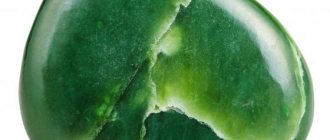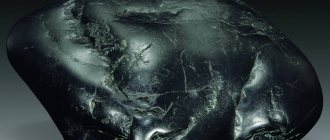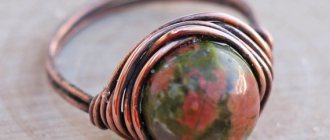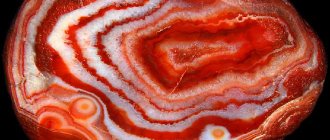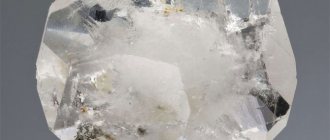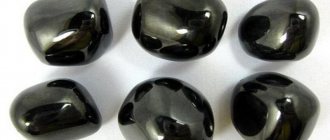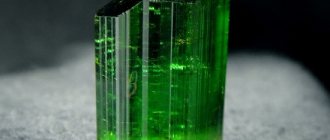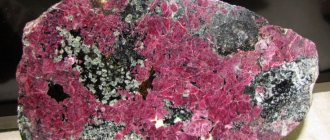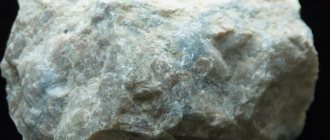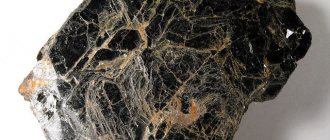Color range of natural jade
The stone is common. Shades of green are familiar to him.
However, rarer and more valuable varieties may come in other colors, such as:
- white (yellowish-white, white-gray, waxy and milky white);
- honey (opaque, all shades of honey);
- gray (grayish green);
- yellow (lemon to brownish, yellowish with milky areas, greenish-yellow);
- blue, light blue (found in Yakutia);
- red (one of the rarest and most expensive);
- black.
Jade is characterized by green shades.
There are stones of a special structure, which gives the jade a “cat’s eye” effect.
All other shades (purple, etc.) indicate an outright fake. And the rarer the color of the jade, the higher the risk of running into it.
The healing properties of jade
Blue jade decoration
Lithotherapists highlight a large number of medicinal properties of jade. Considering the special effect on the human body, it:
- increases the level of immunity;
- optimizes the functioning of the cardiovascular system;
- restores blood pressure;
- reduces pain during contractions;
- normalizes the functioning of the respiratory, cardiovascular, and genitourinary systems;
- removes stones from the kidneys and gall bladder;
- clears the lungs of mucus;
- contributes to the normalization of the gastrointestinal tract;
- due to improved microcirculation of blood in tissues, improves hair growth, complexion and skin tone;
- removes toxins and waste products, free radicals from the intercellular substance and cells;
- relieves menstrual pain and improves potency;
- has a positive effect on vision and hearing;
- saves from insomnia;
- tones the body, giving an influx of vitality.
However, you can feel all the power through direct contact with it, which means the jewelry should be constantly worn or held in your hands. Beauties will appreciate a massage with a Chinese jade massager, and if there is a persistent cough, heated plates of this mineral will speed up the process of removing phlegm.
What is fake jade made from?
Everything that is offered on the jade market can be divided into several groups:
- stones that have not been subjected to any influence other than artistic or jewelry processing;
- nondescript or low-quality natural minerals that have been specially treated to make them more attractive.
Refinement methods can be:
- physical, which change the entire structure of the stone (irradiation, exposure to high temperatures and pressure);
- chemical (impregnation with compounds that increase transparency, or coloring, which is washed out over time, sometimes varnishing).
Fakes are:
- pressed production waste from natural minerals;
- cheap natural stones resembling jade;
- pacifiers made of glass and plastic.
Fake jade is made from natural, cheap stones.
What types of greeds are there?
Stones processed in an ancient way have their true color. Plum juice is used to wash the stones, and beeswax is used to polish them, making the surface of the stone smoother. The unique structure remains due to the rejection of exposure to temperature and high pressure. These are type A stones and have the highest price on the market.
Type B is jades that have undergone chemical treatment. This method is the simplest and most economical for removing impurities. The stones are centrifuged, adding a material that makes the jade more transparent. A durable substance is used as a top coating.
Type C refers to jade dyed for aesthetic purposes, which has also been bleached using a chemical composition. Their color may change over time due to contact with the body or exposure to direct sunlight.
Visual recognition methods
The buyer should be wary of too bright unnatural color, graininess, striping, blurring of the boundaries of color segments, excessive transparency and suspicious uniformity.
Shine on the surface
Jade lends itself well to processing and polishing, but with rare exceptions its shine remains muted, matte, oily, silky, greasy, waxy. This is his distinctive feature.
Real jade has a shine on the surface.
Rough plastic fakes have almost no shine, and all other imitations have it too bright to fit the listed definitions.
Pattern and structure
If, with the help of a magnifying glass, and even more so without it, graininess is clearly visible in the product, then it is definitely not jade. Its structure is a mesh of the finest fibers that make up unique patterns. If the fibers are too obvious or patterned, then it is most likely a crude plastic or glass fake.
Jade can be either uniform (rarely) or patterned. The stone patterns are chaotic and unique. Therefore, their similarity on several products raises suspicion.
The color boundaries of a natural mineral are clearly marked, unlike most fakes.
Due to its structure, jade almost does not transmit light (with the exception of thinned edges or plates 1.5-2 cm wide).
Translucency or transparency in all other cases clearly indicates a fake.
How to distinguish a jade stone from a jadeite
Experienced collectors know how to identify natural jade from other stones based on physical properties and color, but even they are often confused about the difference between jade and jadeite, because both of these stones belong to the same group - jade. High-quality products are extremely similar in appearance. But there are ways to distinguish a jade stone from a jadeite, based on accurate indicators.
Using special equipment, the density of the stone is determined. In jadeite it is literally two tenths higher. High-precision equipment is what anyone who wants to know the stone with the highest probability will need.
Using a magnifying glass or microscope, look at the surface of the stone. The abundance of tangled fibers indicates that the stone is jade, and the fine-grained, “shagreen” surface is most often found in jadeite. This is not true for painted or bleached stones, as well as stones glued together.
Check for mechanical damage
A seller who is confident in the quality of his product and knows how to distinguish jade from a fake willingly demonstrates evidence of the authenticity of the stone. Otherwise, this is a reason for doubt.
It is impossible to spoil natural jade using the methods described below.
Scratching from needles or blades
You can scratch something on the product. If the hardness of such an object is higher than that of the mineral, a mark will remain; if less, the stone will be unharmed. However, you should not scratch the inclusions, which have a different structure and may be damaged.
Fake jade can be scratched with a needle.
The table below will help you preserve your jade product and come to the right conclusions.
Comparative table of hardness on the Mohs scale with permissible deviations of 0.5 in both directions
| Material | Hardness |
| Nephritis | 6 |
| Jadeite, quartz glass, natural quartz | 7 |
| Metal (except aluminum), window glass | 5 |
| Other minerals most often passed off as jade | 4 or less |
That is, a fragment of quartz glass or a piece of quartz will spoil all of the listed minerals, except jadeite. And on the window glass, natural jade itself will leave a mark. A nail, knife, pin, or sewing needle will not harm jade and jadeite, but will scratch other fakes.
However, this method is only suitable for high-quality, hard jades.
Impact strength
High-quality jade is 2 times stronger than steel, which is why in ancient times weapons were made from it. It cannot be broken with a hammer; products made from it remain unharmed when they hit the floor. However, due to its plasticity, when it hits a hard surface, small dents may appear on it.
High-quality jade is stronger than steel.
If the stone still manages to be broken, its fragments will be needle-shaped stone chips.
Test by fire
It is enough to hold the product over the flame for half a minute, and the surface will become smoky. But a black spot on natural jade can be easily wiped off without a trace, unlike a fake. The plastic over the fire will begin to smell burning and melt.
The binder component in the pressed material will not hold up and an unpleasant chemical odor will appear.
It is not recommended to heat the thinned edges of products so that a sharp temperature change does not cause cracks.
Pressed
Natural minerals have always been expensive, be it an animal figurine, a craft, or jewelry.
This is primarily due to the fact that it helps to strengthen the health of its owner, endows him with personal qualities, and helps him cope with emotions. There are many people who want to receive additional help, but not everyone can afford to purchase a natural gem. Therefore, they try to find a product at a lower price. But for some reason no one thinks that a fake is not only useless - it can cause additional harm. Often, instead of real black jade, pressed jade is found in products. How to check the authenticity in this case?
Pressed stone consists of waste after processing of real mineral (fragments, shavings, dust). First they are ground and pressed, and then added to synthetic materials. At the same time, the resulting mixture looks like a natural gem.
On topic: Where is the mineral jade mined and how is it used?
To find out what the craft is made of, you can hold it over the fire for 20–30 seconds (a regular lighter will do). Since plastic is often used to make pressed stone, the product will begin to melt, and you will notice a specific smell. In addition, a dark-colored spot will remain at the point of contact with the fire (although it is hardly noticeable against a black background).
The natural mineral is not subject to deformation from the fire of a lighter , so before you buy the product, ask the seller for permission to test it.
Refusal to conduct the experiment will only indicate that they may be trying to sell you a counterfeit product.
Formal signs of fake jade
First of all, this is the seller’s refusal to examine the goods and the lack of a complete package of accompanying documents.
Low cost
First of all, the suspiciously low price for a clearly unusual specimen should alert you. In Russia, the cost of local minerals and products made from them lags behind world prices, but focusing on domestic prices when purchasing goods abroad is a big mistake.
It is primarily influenced by the color of the stone. So 1 kg of blue or red jades can cost up to 10 thousand dollars.
Of the stones suitable for jewelers, the most valuable are white and deep green, the price of which is at least $50 per 1 carat. The cost of a green jade ball is approximately 350-400 rubles, and a white one - from 600 to 1000. And if a bracelet or beads are offered at the price of 1-2 beads, it means that we are talking about a deliberate fake. But scammers may offer fakes at a higher price for credibility reasons.
The price is influenced by many factors, including subjective assessments. But it is useful to compare average prices in Russia and China, where jade has been valued more than gold since ancient times.
How to use jade
Jade jewelry can become an exotic detail in your look. Original earrings, rings, pendants are a good gift for a loved one. Stones set in a base of silver or white gold look stylish. They are worn both as part of an evening outfit and as everyday decoration. There are those who believe in the magical properties of jade. This stone is national in China. Ancient scriptures say: jade will help you find the path to enlightenment and wisdom, gives vital energy and longevity. People who are interested in esotericism associate the clouding of jade with the bad character of its owner.
With the help of thermal energy, the therapeutic effect of jade is achieved. When exposed to heat, muscles relax. It is useful for tension headaches and neurological diseases. Metabolic processes in tissues are launched, organs receive additional blood flow. Jade products can be used for cosmetic purposes. For example, a mask is a device for relieving eye fatigue and spasm of accommodation, performing acupuncture massage.
Photo comparison of natural stone and fakes
If you photograph the products from the right angle and distance and with the right lighting, then a specialist will be able to distinguish between an item made of natural jade and a fake by its shine and other visual features.
Photo comparison of the original and the fake. Photo comparison of the original and the fake. Photo comparison of the original and the fake. Photo comparison of the original and the fake. Photo comparison of the original and the fake.
What are fakes made from?
The main material for making fakes is waste from working with a genuine gem. The shavings that appear in the process of the work of true masters are collected by cunning businessmen, mixed with synthetic materials, plastic, sometimes dyes are added and put under a press.
External resemblance to the original is easily achieved. But a destroyed stone is dead. And the consequence is a negative impact on the owner of the pressed mineral product. Moreover, no one knows the actual composition of such an alloy. This value is not constant. Using such a product for medicinal purposes becomes extremely dangerous.
It is quite difficult to recognize jade fakes visually due to their external resemblance to other stones. But there is a certain group of qualities that distinguishes a real gem from a surrogate.
| Characteristics of Jade | Usage | Behavior of fakes |
| Delicate melodic consonance when thin plates carved from stone touch | Chinese craftsmen made musical instruments for the lavish ceremonies of the imperial court. | Hard dull short-term sound |
| Glitter with a fatty effect | Durable household and jewelry items | They quickly become cloudy and cannot be restored to their original shine. |
| Tough and durable in nature | Well cut and processed | Absent in nature |
| Transparency, light transmittance | Pleases the eye with an internal pattern | Matte coating that does not transmit light |
Varieties
Dianite . Tradename. Blue jade. The name was received in honor of Princess Diana.
Color from gray-blue to gray-blue.
Chinese masters, who have studied the mineral for centuries, also share its varieties.
For them, there are two main types of this stone:
- Shan-liao - from the mine workings.
- Tzu-er-liao - from streams and rivers.
The latter is valued much higher, since over millions of years, as a rule, only the “heart of jade” remains in the pebbles - the hardest and most homogeneous material.
Their prices differ dramatically.
